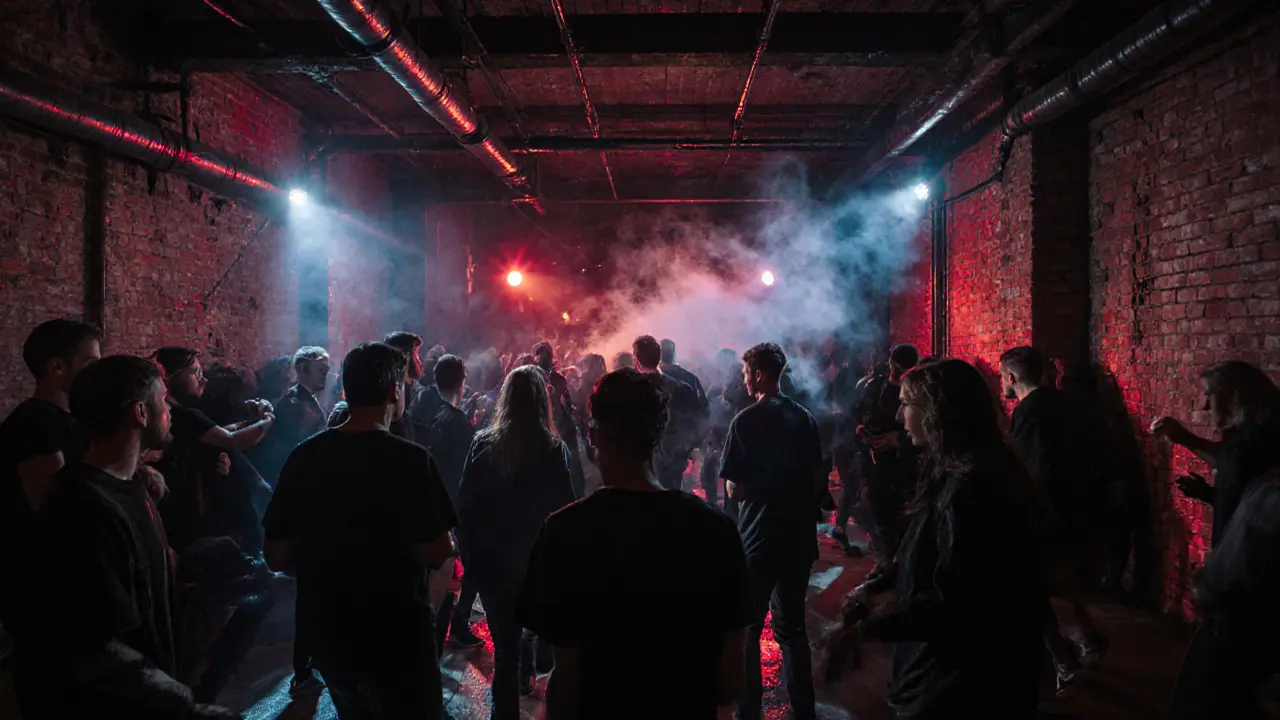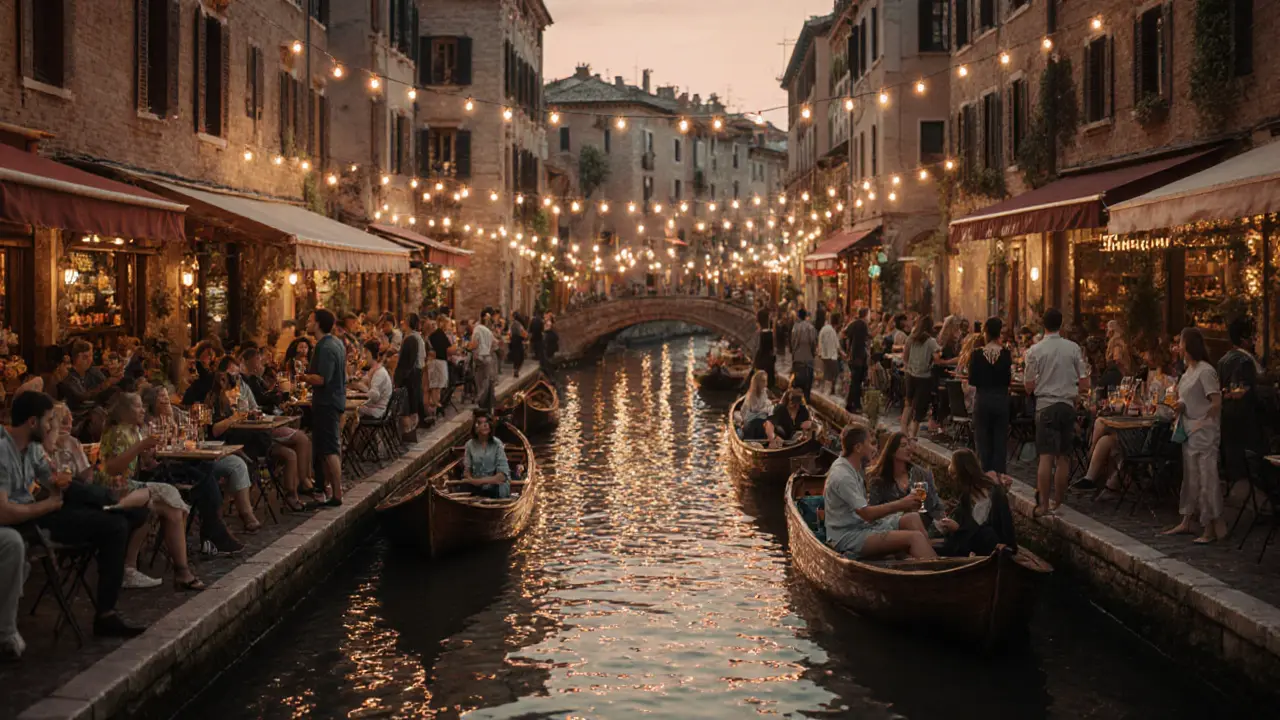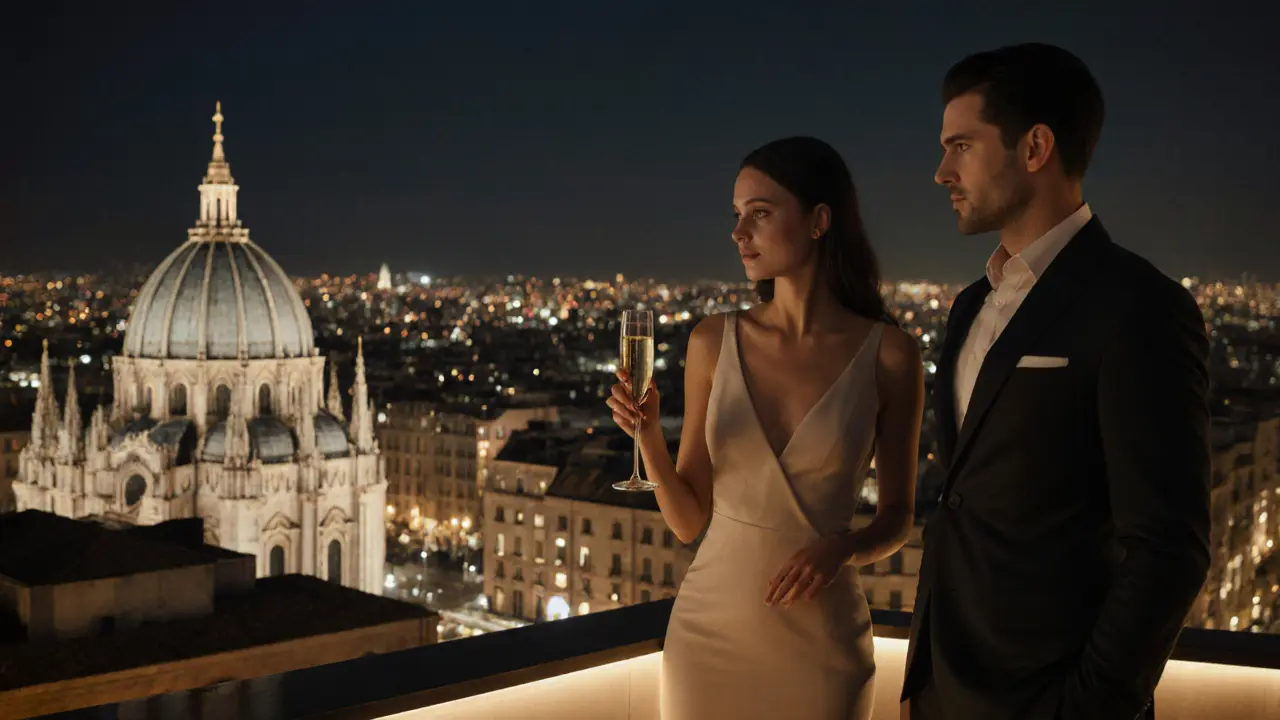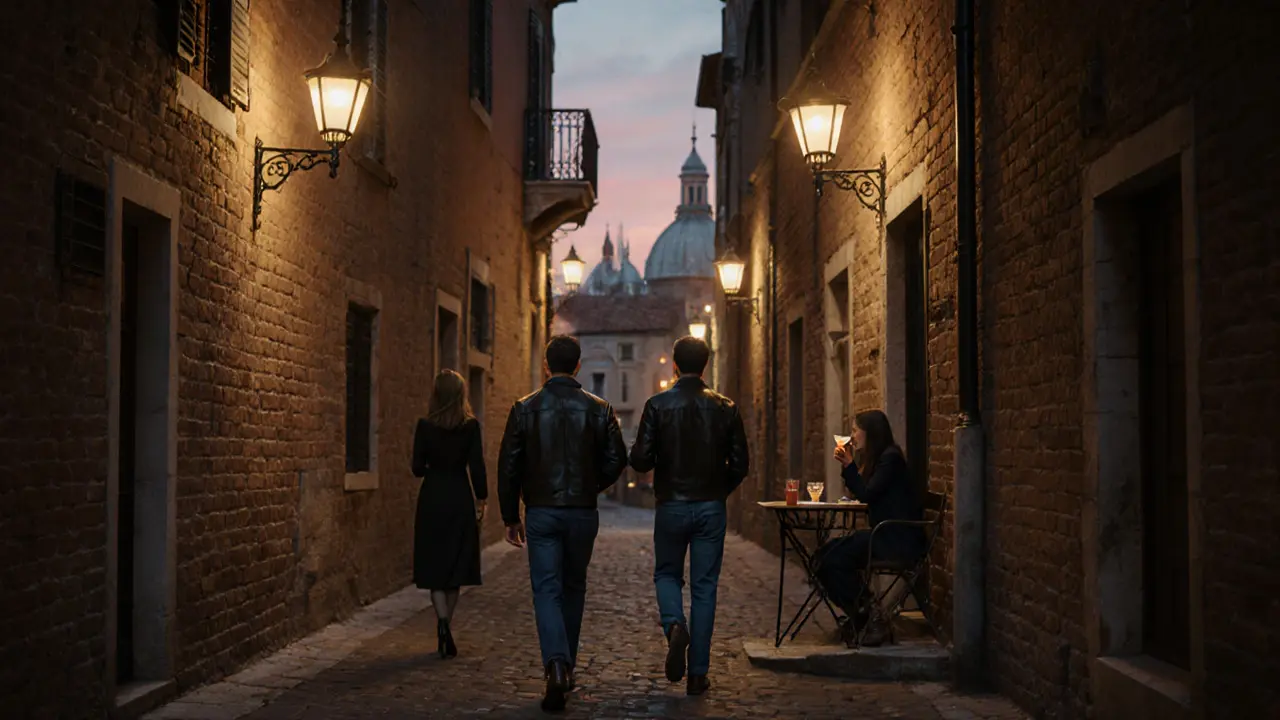Millions of visitors come to Milan for fashion, food, and art-but the real magic happens after sunset. This city doesn’t just shut down when the sun goes down. It wakes up. By 10 p.m., the streets of Brera and Navigli are humming, bass thumps through warehouse doors in Lambrate, and rooftop lounges glow like lanterns over the Duomo. If you think Milan is all about daytime shopping and espresso, you’re missing half the story.
Where the Locals Go: Navigli District
Navigli isn’t just a canal-it’s a living, breathing party zone. Two canals, Darsena and Grande, run through this historic district, lined with over 100 bars, live music venues, and open-air terraces. On Friday and Saturday nights, the sidewalks fill with people in stylish but relaxed outfits, wine glasses in hand, laughing under string lights.
Start at La Bitta, a tiny bar that’s been serving craft cocktails since 1987. Their Aperol Spritz is the gold standard-bright, bitter, and perfectly balanced. Walk ten steps to Bar del Fico, where DJs spin indie rock and vinyl from the 90s. Don’t expect VIP sections or bottle service. This is where Milanese professionals unwind after work. Locals know to come early-by midnight, you’ll be waiting 20 minutes just to get a drink.
By 1 a.m., cross the bridge to Il Covo, a hidden courtyard bar with no sign. You’ll find it by the smell of grilled sardines and the sound of live jazz. This place doesn’t take reservations. You just show up, grab a stool, and let the night decide how long you stay.
The Club Scene: Lambrate and Porta Genova
If you want to dance until sunrise, head east to Lambrate. This former industrial zone is now Milan’s underground club hub. The buildings here still have exposed brick, rusted pipes, and concrete floors-perfect for clubs that don’t care about fancy decor. They care about sound.
Clust is the most talked-about spot. Open since 2019, it’s a 3,000-square-meter warehouse with three rooms: one for techno, one for house, and one for live electronic acts. The sound system? Custom-built by Italian engineers. The crowd? Mostly locals under 35, dressed in black, moving like they’ve been waiting all week. Cover is €15 on weekends, and you’ll usually get in before 1 a.m. if you arrive before the line snakes around the block.
Just down the street, Spazio 51 is older, grittier, and even more authentic. It’s been around since the 90s and still plays raw, unfiltered techno. No VIP tables. No dress code. Just a dim room, a thumping beat, and people who’ve been coming here since they were teenagers. The owner, Marco, still checks IDs at the door. He’ll ask where you’re from. If you say you’re from New York or London, he’ll nod and say, “Good. You know how to dance.”
For something different, try La Pelota in Porta Genova. It’s a mix of a bar, a skate park, and a music venue. Bands play on a stage built over a half-pipe. The crowd is younger, louder, and more eclectic-students, artists, expats. Drinks are cheap: €5 for a beer, €6 for a gin and tonic. They open at 9 p.m. and don’t stop until 6 a.m. on weekends.
Rooftops and High-End Spots: The View Matters
Milan has some of the best rooftop bars in Europe-and they’re not just for tourists. If you want a cocktail with a view of the Duomo, head to Terrazza Aperol on top of the Pirelli Tower. It’s not the cheapest, but it’s the most iconic. Sunset here is unforgettable: the spires of the cathedral turn gold, the city lights flicker on, and the skyline looks like a painting.
Skyline Rooftop Bar at the Westin Palace is quieter, more intimate. They serve classic cocktails made with Italian gin and local herbs. The music is ambient, not loud. Perfect if you want to talk, not dance. The dress code is smart casual-no sneakers, no shorts. You’ll see lawyers, designers, and foreign diplomats here, sipping Negronis and debating art.
For something more unexpected, try La Cucina di Loredana on the 10th floor of a residential building in Brera. It’s not a bar. It’s a secret dinner club that turns into a party after 11 p.m. You need an invitation. You get it by emailing them two days in advance with your name and why you want to come. They don’t ask for money. They just want to know what you’re passionate about. If you answer honestly, you’re in.

What to Avoid
Not every place that looks like a party spot is worth your time. Stay away from the tourist traps near the Duomo. Places like La Scala Bar or Milan Night Club charge €25 just to walk in, play Top 40 hits on loop, and serve overpriced drinks. The crowd is mostly foreign tourists who don’t know the difference between a good DJ and a playlist on Spotify.
Also avoid clubs that require you to book a table. If a place pushes bottle service or VIP packages before you even walk in, they’re more interested in your wallet than your vibe. Milan’s best nightlife thrives on spontaneity. The best nights happen when you wander, follow the music, and let someone you just met point you to the next place.
When to Go and How to Get Around
The nightlife here doesn’t start early. Most bars don’t get busy until 10 p.m. Clubs don’t fill up until midnight. If you’re there before 9, you’ll be the only one. Don’t rush it.
Public transport shuts down at 1:30 a.m., so plan ahead. The metro runs until then, but after that, you’ll need a taxi or ride-share. Uber is available, but local apps like Free Now or ItTaxi are cheaper and faster. Most drivers know the club districts by heart. Just say “Lambrate” or “Navigli” and they’ll get you there.
Weekends are packed. If you want to avoid crowds, go on a Thursday or Friday. Saturdays are the busiest, but also the most electric. Sundays are quiet-except for Il Covo, which sometimes stays open until noon for brunch parties with live funk.

What to Wear
Milanese style is effortless. You don’t need to look like a model, but you do need to look intentional. No hoodies, no flip-flops, no baseball caps. Men: dark jeans, clean sneakers or loafers, a fitted shirt. Women: a dress, tailored pants, or stylish jumpsuits. Think “I woke up like this” but make it chic.
At rooftop bars, dress a little sharper. A blazer or a nice coat goes a long way. At Lambrate clubs, it’s all about comfort and confidence. If you look like you belong, you’ll get in. If you look like you’re trying too hard, you might get turned away.
Final Tip: Follow the Music
The best night in Milan doesn’t start at a club. It starts when you hear a beat coming from an alley you didn’t notice before. Maybe it’s a DJ spinning from a balcony. Maybe it’s a group of friends dancing on a rooftop. Maybe it’s a hidden basement bar with no sign and no name.
Don’t check Instagram for the “best” spot. Don’t follow a list. Walk. Listen. Let the city guide you. That’s how you find the real Milan after dark.
What time do clubs in Milan usually open?
Most clubs in Milan don’t get busy until midnight, and many don’t even open their doors until 1 a.m. Bars and lounges start filling up around 10 p.m., but the real party kicks off after 1 a.m. If you show up before midnight, you’ll likely be one of the first people there.
Is Milan nightlife expensive?
It depends on where you go. Rooftop bars like Terrazza Aperol charge €15-20 for a cocktail. But in Lambrate or Navigli, you can get a beer for €5-7 and a cocktail for €8-10. Cover charges for clubs range from €10 to €20. Avoid tourist traps near the Duomo-they charge double for the same drink and play generic playlists.
Do I need to book a table in advance?
Only for high-end rooftop bars or private events. For clubs like Clust or Spazio 51, booking a table is unnecessary and often a sign the place is more focused on profit than vibe. Just show up early, especially on weekends. Lines form quickly, but getting in is easy if you’re dressed right and patient.
What’s the dress code in Milan’s nightlife?
Milan is stylish but not rigid. No hoodies, no sneakers at rooftop bars, no shorts or flip-flops anywhere after dark. Men: dark jeans, clean shoes, a button-down or fitted tee. Women: dresses, tailored pants, or chic jumpsuits. The goal isn’t to look rich-it’s to look like you belong. Confidence matters more than labels.
Is it safe to go out at night in Milan?
Yes, especially in the main nightlife districts like Navigli, Lambrate, and Brera. These areas are well-lit, crowded, and patrolled. Avoid isolated streets after 3 a.m. and don’t walk alone if you’ve had too much to drink. Use ride-share apps like Free Now or ItTaxi instead of hailing cabs on the street. Overall, Milan is one of the safest major European cities for nightlife.



